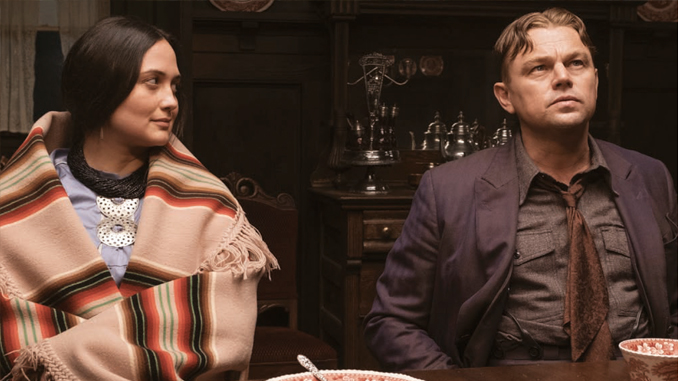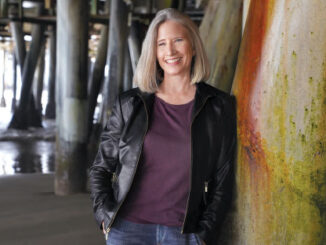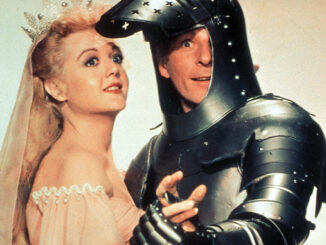
By Patrick Z. McGavin
Thelma Schoonmaker, ACE, knows that her famous collaborator embraces the challenge of the new.
“Marty never wants to repeat himself,” said Schoonmaker, the three-time Oscar-winning editor best known for her work with director Martin Scorsese on film classics such as “Raging Bull” and “Goodfellas.” “He gets a great new idea he wants to challenge himself with, and I’m being challenged with him,” she added. “There’s never any boredom.” Their latest challenge is the Apple-financed $200 million production, “Killers of the Flower Moon,” adapted by the writer Eric Roth and Scorsese from the 2016 non-fiction book by David Grann.

Set in 1921 in northern Oklahoma, the film is a story of greed, corruption, and racism after the discovery of oil under Osage Nation land transformed the region into one of the wealthiest areas in the country. Leonardo DiCaprio plays Ernest Burkhart, a returning World War I soldier ensnared in a scheme concocted by his uncle, William Hale, a nefarious cattle baron played by Robert DeNiro. The emotional centerpiece is the relationship between the Osage woman Mollie (Lily Gladstone) and Ernest, who starts as her chauffeur and eventually marries her. Like Scorsese’s Netflix epic “The Irishman” (2019), this new Apple Original film is a historical epic with a three-and-a-half-hour running time.
In an interview with CineMontage, Schoonmaker talks about the challenges of finding a balance between the film’s violent historical context and its more subtle family dynamics.
CineMontage: How did you prepare for this daunting material? Thelma Schoonmaker: Of course, I read the book, and that is filled with information. I learned many things through the process as I was going. I was given books, for example, on the very interesting ways Osage dress for weddings. The women wear this military outfit, which is something that happened when they first encountered white people.
They probably admired the look of the epaulets. Things like that I learned as each scene came up. It was the same with pipe at the beginning, and the drums at the end. The drums are so important to the Osage. They actually consider the drum a person, and the keeper of the drum is a very special person who is carefully chosen. Then it’s handed from person to person as people get older. I was learning all of that with each scene.
CineMontage: How did you decide to weave in the other narrative blocks, like the illustrated Osage book, the use of photographs and film, or the intertitles?
Schoonmaker: Marty knew right away that he wanted to use the black-and-white scenes, which were shot with actual silent cameras by [cinematographer] Ellen Kuras. The idea of using silent film footage in the beginning, once the oil was discovered, was to reproduce exactly as a newsreel of those days would have looked. It was shot by Ellen Kuras with a silent film camera using black-and-white film stock. Marty even owns one of the cameras. He always knew that, instead of a different way of explaining what happened, which may be lengthy and maybe not as interesting, that he wanted to use the silent film as a way to let people know what happened and not spend a lot of time on it.
Marty said, “I’m not making a documentary about the Osage. I’m making a film about two people who are in love with each other.”
CineMontage: One of the most striking cuts happens early, with an overhead shot and Mollie’s voiceover as we see these tableaux of sorrow, violence, and loss. Thelma
Schoonmaker: That was kind of a daring thing we did with Mollie’s voice there. We haven’t seen her yet. We don’t know who she is. Hearing a woman’s voice over these men who have died, and women who have died, and there’s been no investigation of it as a criminal act — hearing that female voice is such a shock.
CineMontage: The movie is a marriage story. The key question is how authentic Ernest’s love for Mollie is. How does the cutting color that ambiguity? Schoonmaker: DiCaprio was originally going to play the FBI man. What happened was once he decided to play Ernest, both he and Lily helped Marty revise the script and make the love story the central theme of the movie. You might wonder, but most people tell me they completely believe the love story, which is the way wonderful actors do it. An FBI agent asked Mollie, “Why are you staying with him?” She said, “I love him.” The actors make it that way. Leo is wonderful at improvisation. There’s the scene where Mollie calls him over to the bed. He’s been watching Blackie steal his car, the stupid plot that the two of them came up with.
She said, “I don’t know if you love me anymore,” and he convinces her he does. They say to each other, in Osage, “I love you,” and they touch noses, which is the Osage way of expressing love. During the intimate moment, he improvises, and they laugh, and he says, “You’re going to wake up the kids.”
CineMontage: With your long history of cutting both Leonardo DiCaprio and Robert DeNiro at different parts of their careers, how beneficial was that in capturing their specific styles and emotional ranges?
Schoonmaker: They are both so different in this movie from what I expected, particularly Leo. He is willing to play someone who is not very smart, who’s lazy, but who loves this woman. That’s a big departure from the roles that he normally plays. I was astonished to see how skillfully he was able to switch into this kind of a part, and how he was absolutely adamant about staying in it. He never wanted to make himself look glamorous or romantic. He wanted to develop that part as it should have been. DeNiro is also very different in this. I couldn’t believe his voice. He came up with this wonderful voice that shows a bit of age, but it’s got a very interesting character. He said at the press conference at Cannes that he really didn’t understand his character.
He played it beautifully, in spite of the fact that he couldn’t really personally identify with such a thing. There are many people in films like that, characters who are double-sided. It’s hard to handle, like “Peeping Tom” (1960), my husband Michael Powell’s film, where you feel compassion for this man who is killing people. My husband felt this man had been tortured and abused as a child, and he can’t help himself. The compassion the critics were feeling when they first saw the movie made them so uncomfortable. They felt they were guilty of supporting his crimes.
CineMontage: Scorsese has been criticized sometimes for the female representation in his films. Lily Gladstone is the soul of the film. What was your process like with her?
Schoonmaker: She is such a wonderful actress, a genius. She’s a Blackfoot who learned the Osage language. The woman who trained her in Osage said, “She sounded like my mother.” I noticed sometimes that even after Marty said, “Cut,” she would stay in character for the two or three feet it takes for the film to run out. This is a part to die for. She is the soul of the movie, her dignity, and her willingness to compromise for the man she chooses to be with. She’s attracted to him, and he’s attracted to her. I didn’t have to do anything to make her performance any better than it already is.
CineMontage: The FBI investigation is more pronounced in the book. How much did you play around with how you wanted to introduce that element?
Schoonmaker: Marty had already had to make big changes once Leo decided he didn’t want to play the FBI agent. That work was going on even a little bit during the shooting, particularly building the love story. That it was going on during shooting was a little unusual, but it’s happened before. We experimented with placing scenes around the love story, to make sure the love story was strengthened. With editing, you do move things around.
CineMontage: Did you watch the early ’20s films of D.W. Griffith, John Ford, or Erich von Stroheim to get a feel for how things moved back then?
Schoonmaker: Marty is already so familiar with that period of movies that it’s sort of in his brain already. I didn’t have to look at those movies. I knew a lot of the ones that mean the most to him.
CineMontage: The movie was shot on 35mm film. What impact, if any, did that have on your work? Schoonmaker: We do make the transition to digital right away for editing purposes. We had very highresolution footage all the way through when we were editing. So it wasn’t a matter of us having to go back when we did, for example, with an optical visual effect. We didn’t have to go back and get the negative because we already had high-quality resolution negative, which meant things were faster and we could manipulate things even more in the editing room.
We created some visual effects in the editing room, and that was because we were shooting at a very high resolution. That was really different from previous films. We have this high-resolution element for the final.
CineMontage: How do you and Scorsese resolve any differences you might have?
Schoonmaker: There is never an ego battle or anything like Marty used to have in his early days in Hollywood when he was changing the ways movies are made. If we disagree, I show him four or five options of another way to go, and he will look at it, and we will decide together which is better. It’s not ever a problem.
Sometimes we may want to screen one way, then try screening another way to gauge audience reactions when we debrief them afterwards. We settle these things in the early editing. He trained me. He taught me everything I know about editing. Our sensibilities are the same.
CineMontage: With Netflix on “The Irishmen,” and now Apple with this film, you are working outside the traditional commercial restraints. Has that been liberating artistically?
Schoonmaker: It’s the nature of the subject matter, like the long slow builds of how De Niro’s character in “The Irishman” evolved to the absolutely devastating last scene, where he’s aging and all alone. That’s what he’s earned from how he ran his life. So that build was very, very important. Similarly with this film, it’s a big story, and it needed the length. Most people tell me they have no problem at all with it. So they feel gripped by the movie right away and stay that way.
CineMontage: Criterion has recently issued 4K editions of “Mean Streets” (1985), “After Hours” (1985), and your husband’s key film, “The Red Shoes” (1948). Does this lead you to reflect on your life and work?
Schoonmaker: I do the restorations myself. I work with Scorsese, and we work very closely with the colorist and the sound restoration. “After Hours” was something we spent a great deal of time on. It’s wonderful to see the film brought to life again, particularly these days with digital. You can do these amazing things to remove dirt and scratches and get the sound and color exactly right.
I’ve worked on the restoration with Scorsese of almost all the recent movies, and also my husband’s movies. The wonder-ul thing about it is you see the same scene over and over again as you are working on the color, so you get to learn the film in a different way. You see little things that you never noticed, particularly on my husband’s films. That is a joy. I love every minute of it, and I never get tired of seeing them.
Patrick Z. McGavin is a Chicago-based writer and cultural journalist.





